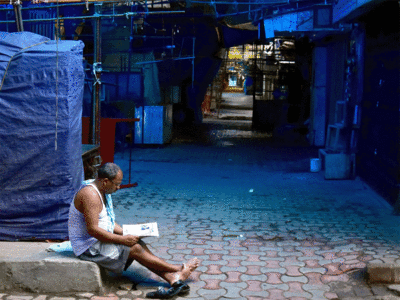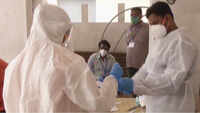
HYDERABAD: Madhya Pradesh is most vulnerable to the long-term effects of Covid-19 pandemic, followed by Bihar and Telangana, says a study published in the medical journal ‘Lancet.’
The study, ‘A vulnerability index for the management of and response to the Covid-19 epidemic in India: An ecological study’, shows Sikkim at score ‘0’ in the rankings, making it the least vulnerable state. Madhya Pradesh has scored ‘1’ on the overall vulnerability scale while Bihar’s vulnerability is calculated to be 0.971.
While focussing on the exodus of migrant workers from cities during the lockdown, the study says, “most of these people travelled to UP and Bihar, followed by MP, Punjab, Rajasthan, Uttarakhand, J&K and West Bengal. And, indeed, we observed that these are some of the most vulnerable states according to the vulnerability indices.”
According to the researchers, MP has the highest vulnerability due to housing and hygiene condition (0.971) which is highest among all states. Also, vulnerability is high due to socio economic conditions (0.886) and weak healthcare infrastructure (0.857).
Bihar’s weak link is non-availability of healthcare (0.971). It fared poorly on hygiene (0.800) and socio-economic conditions (0.714) as well.
“The objective of the study is to see how vulnerable the population is to the effects of the pandemic. For example, it studied how a particular state will be impacted due to its socio-economic condition, housing and hygiene conditions among others,” says Dr Rajib Acharya of the Population Council, New Delhi, one of the authors of the study along with Akash Porwal, also from the same organsation.
“Telangana has a very high epidemiological vulnerability (0.8) and vulnerability due to non-availability of healthcare is high (0.65). Vulnerability due to housing and hygiene conditions (0.629) is high as well,” added Acharya.
The researchers collected data from a number of publicly available sources like National Family Health Survey 2015–16, Census, Rural Health Statistics 2018, and National Health Profile 2019.
The study points out that districts with higher vulnerability are more likely to get poorer. “These areas are already poor and are therefore more likely to be impacted economically as more people are likely to lose jobsas an impact of the illness," said Acharya.
The study, ‘A vulnerability index for the management of and response to the Covid-19 epidemic in India: An ecological study’, shows Sikkim at score ‘0’ in the rankings, making it the least vulnerable state. Madhya Pradesh has scored ‘1’ on the overall vulnerability scale while Bihar’s vulnerability is calculated to be 0.971.
While focussing on the exodus of migrant workers from cities during the lockdown, the study says, “most of these people travelled to UP and Bihar, followed by MP, Punjab, Rajasthan, Uttarakhand, J&K and West Bengal. And, indeed, we observed that these are some of the most vulnerable states according to the vulnerability indices.”
According to the researchers, MP has the highest vulnerability due to housing and hygiene condition (0.971) which is highest among all states. Also, vulnerability is high due to socio economic conditions (0.886) and weak healthcare infrastructure (0.857).
Bihar’s weak link is non-availability of healthcare (0.971). It fared poorly on hygiene (0.800) and socio-economic conditions (0.714) as well.
“The objective of the study is to see how vulnerable the population is to the effects of the pandemic. For example, it studied how a particular state will be impacted due to its socio-economic condition, housing and hygiene conditions among others,” says Dr Rajib Acharya of the Population Council, New Delhi, one of the authors of the study along with Akash Porwal, also from the same organsation.
“Telangana has a very high epidemiological vulnerability (0.8) and vulnerability due to non-availability of healthcare is high (0.65). Vulnerability due to housing and hygiene conditions (0.629) is high as well,” added Acharya.
The researchers collected data from a number of publicly available sources like National Family Health Survey 2015–16, Census, Rural Health Statistics 2018, and National Health Profile 2019.
The study points out that districts with higher vulnerability are more likely to get poorer. “These areas are already poor and are therefore more likely to be impacted economically as more people are likely to lose jobsas an impact of the illness," said Acharya.
Download
The Times of India News App for Latest India News

Coronavirus outbreak
Trending Topics
LATEST VIDEOS
India
 India firmly stands for freedom of navigation in South China Sea, says MEA
India firmly stands for freedom of navigation in South China Sea, says MEA  Covid-19 in India: Coronavirus cases set to cross 10 lakh-mark
Covid-19 in India: Coronavirus cases set to cross 10 lakh-mark  MP farmer calls CM helpline for hand pump repair; gets declared ‘mad’ in govt response
MP farmer calls CM helpline for hand pump repair; gets declared ‘mad’ in govt response  Cross-border movement from Bihar hasn’t stopped despite lockdown: Jharkhand CM Hemant Soren
Cross-border movement from Bihar hasn’t stopped despite lockdown: Jharkhand CM Hemant Soren  India in touch with UAE for investigating Kerala gold smuggling case: MEA
India in touch with UAE for investigating Kerala gold smuggling case: MEA  India, China agreed for complete disengagement at LAC: MEA
India, China agreed for complete disengagement at LAC: MEA
More from TOI
Navbharat Times
Featured Today in Travel
Quick Links
Coronavirus in MumbaiCoronavirus in KolkataCoronavirus in HyderabadCoronavirus in DelhiCoronavirus in BangaloreCoronavirus symptomsCoronavirus in IndiaWhat is CoronavirusCoronavirus NewsSolar EclipseNPRWhat is NRCCAB BillCAB and NRCRTI BillPodcast newsLok SabhaShiv SenaYSRCPCongressBJP newsUIDAIIndian ArmyISRO newsSupreme Court
Get the app



